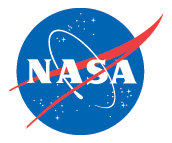



The Cassini-Huygens Mission is the European Space Agency's (ESA) first planetary atmospheric entry mission. They supplied the Huygens probe for the mission, which will be the first probe to land on a world in the outer Solar System.
Huygens has 2 parts:
The probe weighs 318 kg (about 701 lbs). It consists of the Entry Assembly (ENA) and the Descent Module (DM).
The ENA connects Huygens to Cassini until it performs the ejection of the probe. Once Huygens is ejected, ENA controls its journey to Titan. It also provides thermal protection for the probe during its entry into Titan's atmosphere and the 9 m (or 28 ft) parachute that slows the probe down so it can land safely on Titan. Once ENA has done all this, it is jettisoned and releases the DM.
The DM has an outer shell of aluminum which houses an inner structure of all the experiments and probe support subsystems.
The PSE weighs 30 kg (about 66 lbs). The PSE consists of 4 electronic boxes - 2 Probe Support Avionics (PVA), 1 Receiver Front End (RFE), and 1 Receiver Ultra Stable Oscillator (RUSO) - that provide control and communication between Cassini and Huygens before Huygens is released. Once Huygens is launched, the PSE remains attached to Cassini.
Not only will Huygens be the first spacecraft to land on a world in the outer solar system, but it will also provide scientists with the first direct sampling of Titan's atmosphere and the first photographs of Titan's surface. Scientists are not sure what Huygens will land on - a chemical ocean, dry land, or slush. It would be ideal if Huygens landed in an ocean because the probe is best equipped to deal with that - in an ocean, Huygens would float, thus allowing it to stay upright and easily transmit the data.
Huygens has 6 different instruments (listed below). Each was developed by a different international team:
This instrument consists of sensors that measure the physical and electrial properties in the atmosphere.
Visit their website
This instrument possesses a suite of sensors that will be used to determine the physical properties of the surface at the site where the probe hits. It will also provide information about the surface composition. The SSP measures the index of refraction, temperature, thermal conductivity, heat capacity, speed of sound, and dielectric constant of liquid material at the impact site.
The SSP was developed by the Open University (United Kingdom) and is supported by ESA, Italy, and the United States.
The DWE uses radio signals to deduce atmospheric properties, such as wind speed.
The DWE was devleoped by the University of Bonn (Germany), with collaboration from Italy and the United States.
Visit their website
The DISR will take images and make spectral measurements. About 100 m (328 ft) before Huygens impacts Titan's surface, the DISR will turn on its lamp and take spectra of the surface material.
The DISR was developed by the University of Arizona, with support from Germany and France.
Visit their website
The ACP collects aerosols for chemical-composition analysis. The chemical analysis is performed by the GCMS.
The ACP was developed by the French, with support from Austria and the United States.
Visit their website
The GCMS was developed by the Atmospheric Experiment Branch at NASA Goddard Space Flight Center.
With 6 instruments aboard the probe, Huygens will be processing a large amount of data. Once Huygens runs out of battery power, Cassini will shift its attention to using its own 12 instruments.
For more information about Huygens, visit the ESA website.
For more about the Science, look at Huygens Science Operations.